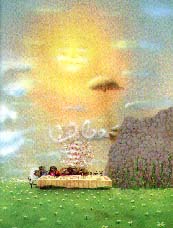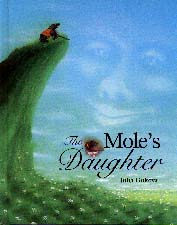|
________________
CM . . . .
Volume V Number 2 . . . . September 18, 1998
excerpt: A mole and his wife had raised the most beautiful daughter imaginable. She seemed perfect in every way. One day her father said to her mother, "I can hardly imagine marrying her off to a mere mole. She is so exquisite, she must have the most highly respected, most powerful husband in the world. The sky is the limit."  So begins the story of a misguided father who, blinded by pride for his beautiful daughter, successively offers his daughter's paw in marriage to the sky, sun, cloud, and wind. Each element relates its unworthiness, and suggests a more powerful suitor, ending finally with a stone wall that resists the pressure of wind, rain or sun. As the family contemplates the wall, a young mole appears, having burrowed under it, and the daughter manages to convince her father that the mole is a more suitable husband
because the wall was powerless to stop him. All ends happily with a wedding feast in the open, attended by sun, wind, cloud and wall.
So begins the story of a misguided father who, blinded by pride for his beautiful daughter, successively offers his daughter's paw in marriage to the sky, sun, cloud, and wind. Each element relates its unworthiness, and suggests a more powerful suitor, ending finally with a stone wall that resists the pressure of wind, rain or sun. As the family contemplates the wall, a young mole appears, having burrowed under it, and the daughter manages to convince her father that the mole is a more suitable husband
because the wall was powerless to stop him. All ends happily with a wedding feast in the open, attended by sun, wind, cloud and wall.
This version of the traditional mouse bride tale originates from Korea and uses moles as protagonists, rather than the more usual mice or rats originating throughout Asia and the Far East. The tale is retold simply but uses beautifully expressive language. The daughter is alternately referred to as "exquisite, remarkable, a singular beauty" and "extraordinary." The dusty old wall is described as "a massive, ancient stone structure of awe-inspiring height and depth." The strength of this book, however, is in the surrealistic illustrations by Julia Gukova from Moscow. Gukova, who has won international awards from several countries, turns her considerable talents on this folktale for Annick here in Canada. Employing hazy landscapes in muted shades on double page spreads, Gukova expresses the immensity of the natural elements compared to the small mole. She constructs the faces of the elements in various ways. The sky's features are created from wisps of clouds, the sun's glowing face is roundly beatific and the cloud's profile is cleverly disguised and visible only when the book is turned sideways. The wind's disembodied mouth, nose and separate eyes have been blown asunder across two pages and are not arranged into a face. This may be appropriate for a strong, gusting wind; however, it may be confusing to a small child. In the final double page illustration of the wedding party, Gukova's softly rendered sky contains the four elements smiling down upon the bashful bride and her adoring groom. In light of recently published 'politically correct tales', this folktale is somewhat culturally anachronistic. Young girls (and presumably moles) no longer wait until their fathers have found suitable husbands. Until the daughter outsmarts him at the end, her conduct is that of a dutiful female child who reacts to her father's unwavering quest by sobbing and is consoled by her equally passive mother. When the young mole suddenly emerges from his molehill, however, we realize that the females have intelligently assessed the situation. The daughter quickly uses the opportunity presented to enlighten her father as to the superior nature of moles and, thereby, satisfy his requirements for her suitor. The mother immediately supports this argument and, in addition, appeals to his pride by exclaiming that his daughter is wise as well as beautiful. Thus the tables are turned, and the reader shares in the joke played on the well-meaning father. Today's children can certainly appreciate the humour and delight in the timeless pleasure a happy ending delivers. Recommended. Alison Mews is the Coordinator of the Centre for Instructional Services, Faculty of Education, Memorial University of Newfoundland in St. John's.
To comment on this title or this review, send mail to cm@umanitoba.ca.
Copyright © the Manitoba Library Association.
Reproduction for personal use is permitted only if this copyright notice
is maintained. Any other reproduction is prohibited without
permission.
Published by
TABLE OF CONTENTS FOR THIS ISSUE - SEPTEMBER 18, 1998.
AUTHORS |
TITLES |
MEDIA REVIEWS |
PROFILES |
BACK ISSUES |
SEARCH |
CMARCHIVE |
HOME
|

